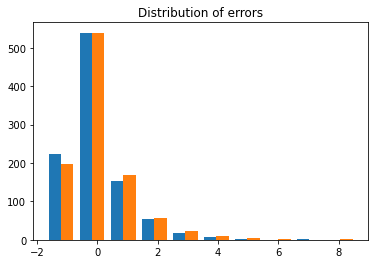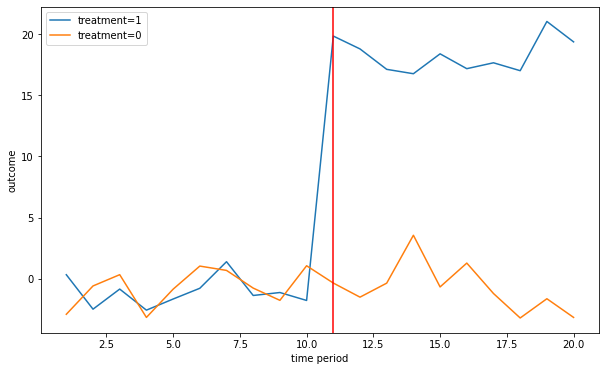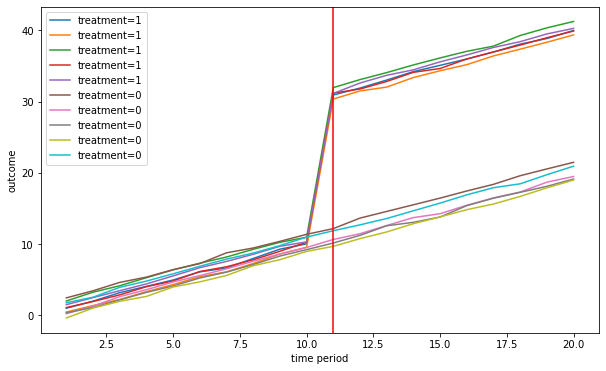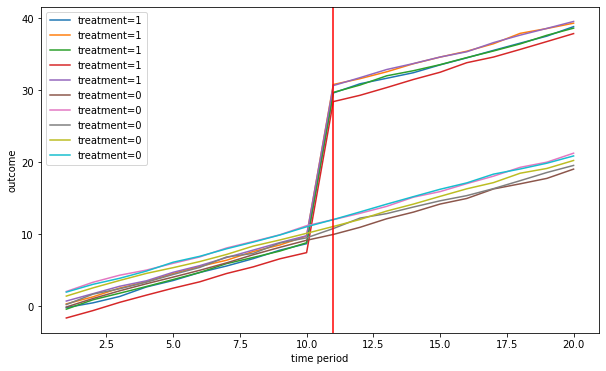Causal Inference - Differences-in-Differences
import pandas as pd
import numpy as np
import random
import statsmodels.api as sm
from sklearn.model_selection import cross_val_score
from sklearn.model_selection import RepeatedKFold
from sklearn.linear_model import Lasso
from sklearn.feature_selection import SelectFromModel
import matplotlib.pyplot as plt
from tqdm import tqdm
import statsmodels.api as sm
import itertools
import copy
random.seed(10)
img_dir = '/Users/ida/Google Drive/Big Data Econometrics/Slides/images/'
def fn_generate_cov(dim,corr):
acc = []
for i in range(dim):
row = np.ones((1,dim)) * corr
row[0][i] = 1
acc.append(row)
return np.concatenate(acc,axis=0)
def fn_generate_multnorm(nobs,corr,nvar):
mu = np.zeros(nvar)
std = (np.abs(np.random.normal(loc = 1, scale = .5,size = (nvar,1))))**(1/2)
# generate random normal distribution
acc = []
for i in range(nvar):
acc.append(np.reshape(np.random.normal(mu[i],std[i],nobs),(nobs,-1)))
normvars = np.concatenate(acc,axis=1)
cov = fn_generate_cov(nvar,corr)
C = np.linalg.cholesky(cov)
Y = np.transpose(np.dot(C,np.transpose(normvars)))
# return (Y,np.round(np.corrcoef(Y,rowvar=False),2))
return Y
def fn_randomize_treatment(N,p=0.5):
treated = random.sample(range(N), round(N*p))
return np.array([(1 if i in treated else 0) for i in range(N)]).reshape([N,1])
def fn_bias_rmse_size(theta0,thetahat,se_thetahat,cval = 1.96):
b = thetahat - theta0
bias = np.mean(b)
rmse = np.sqrt(np.mean(b**2))
tval = b/se_thetahat
size = np.mean(1*(np.abs(tval)>cval))
# note size calculated at true parameter value
return (bias,rmse,size)
def fn_plot_with_ci(n_values,tauhats,tau,lb,ub,caption):
fig = plt.figure(figsize = (10,6))
plt.plot(n_values,tauhats,label = '$\hat{\\tau}$')
plt.xlabel('N')
plt.ylabel('$\hat{\\tau}$')
plt.axhline(y=tau, color='r', linestyle='-',linewidth=1,
label='True $\\tau$={}'.format(tau))
plt.title('{}'.format(caption))
plt.fill_between(n_values, lb, ub,
alpha=0.5, edgecolor='#FF9848', facecolor='#FF9848',label = '95% CI')
plt.legend()
def fn_group_to_ind(vecG,n_g):
"""
Transform group effects vector of length G into an n-length individual effects vector
"""
# g = len(vecG)
# return np.concatenate([np.concatenate([vecG[g] for i in range(n_g)]) for g in range(G)]).\
# reshape([n,1])
return np.array(list(itertools.chain.from_iterable(itertools.repeat(x,n_g) for x in vecG)))
def fn_ind_to_panel(vec,T):
"""
Transform (n x 1) vector of individual specific effect to an (n x T) matrix
"""
return np.concatenate([vec for i in range(T)],axis =1)
def fn_mat_wide_to_long(mat,n,T):
"""
Take (n x T) matrix and output nxT vector with observations for each t stacked on top
"""
return np.concatenate([mat[:,i] for i in range(T)]).reshape([n*T,1])
def fn_create_wide_to_long_df(data,colnames,n,G,T):
"""
Take list of matrices in wide format and output a dataframe in long format
"""
n_g = n/G # number of observations in each group
if n_g.is_integer()==False:
print('Error: n_g is not an integer')
else:
n_g = int(n_g)
group = np.concatenate([fn_group_to_ind(np.array(range(G)).reshape([G,1]),n_g) for i in range(T)])
if len(data)!=len(colnames):
print('Error: number of column names not equal to number of variables')
dataDict = {}
for i in range(len(colnames)):
dataDict[colnames[i]] = fn_mat_wide_to_long(data[i],n,T)[:,0]
dataDict['group'] = group[:,0]+1
dataDict['n'] = 1+np.concatenate([range(n) for i in range(T)])
dataDict['t'] = 1+np.array(list(itertools.chain.from_iterable(itertools.repeat(i,n) for i in range(T))))
return pd.DataFrame(dataDict)
# def fn_generate_grouped_panel(n,G,T,n_treated,treat_start,beta,delta,linear_trend = False):
# n_g = n/G # number of observations in each group
# if n_g.is_integer()==False:
# print('Error: n_g is not an integer')
# else:
# n_g = int(n_g)
# alphaG = np.random.normal(1,1,[G,1]) # (G x 1) group fixed effects
# alpha_i = fn_group_to_ind(alphaG,n_g) # (n x 1)
# treatG = np.zeros([G,1])
# treatG[:n_treated,] = 1
# treat_i = fn_group_to_ind(treatG,n_g) # (n x 1)
# # convert to (n X T)
# if linear_trend==True:
# gamma = np.vstack([np.array(range(T)) for i in range(n)])
# else:
# gamma = np.ones([n,1])*np.random.normal(0,1,[1,T]) # (n x T) # time specific effects
# alpha = fn_ind_to_panel(alpha_i,T)
# treat = fn_ind_to_panel(treat_i,T)
# treat = np.concatenate([0*treat[:,:treat_start],treat[:,treat_start:]],axis = 1)
# sig = (np.random.chisquare(2,[n,1])/4+0.5)**(1/2)
# eps = sig*((np.random.chisquare(2,[n,T])-2)*0.5) # (n x T)
# X = np.concatenate([fn_generate_multnorm(n,.5,1) for i in range(T)],axis =1) # (n x T)
# Y = alpha + gamma + beta*treat + delta*X+eps
# return [Y,alpha,gamma,treat,X]
def fn_plot_dd(dfg,treat_start,fig_name=False):
"""
Plot average outcome Y by group
"""
Yg = dfg[['Y','I','group','t']].groupby(['group','t']).mean().reset_index()
treatStatus = dict(zip(Yg[Yg.t==Yg.t.max()]['group'],Yg[Yg.t==Yg.t.max()]['I']))
fig = plt.figure(figsize = (10,6))
for g in Yg.group.unique():
plt.plot(Yg[Yg.group==g]['t'],Yg[Yg.group==g]['Y'],label = 'treatment={}'.format(int(treatStatus[g])))
plt.axvline(x=treat_start+1,color = 'red')
plt.xlabel('time period')
plt.ylabel('outcome')
plt.legend()
if fig_name:
plt.savefig(img_dir + 'dd1.png')
def fn_within_transformation(dfg,varlist,group_var):
"""
Transform each variable in the varlist using the within transformation to eliminate
the group-fixed effects
"""
dfm = dfg[varlist+[group_var]].groupby([group_var]).mean().\
reset_index().\
rename(columns = {k:'{}_bar'.format(k) for k in varlist})
dfg = dfg.merge(dfm, on = ['group'],how = 'left')
dfg['const'] = 1
for v in varlist:
dfg['{}_w'.format(v)] = dfg[v] - dfg['{}_bar'.format(v)]
return dfg
Statsmodels sandwich variance estimators https://github.com/statsmodels/statsmodels/blob/master/statsmodels/stats/sandwich_covariance.py
1. Generate data
$Y_{it} = W_{it}\tau_{it}+\mu_i+\delta_t+\varepsilon_{it}$
$\varepsilon_{it}^{\left( r\right) }/\sigma_{i}\sim IID\left[\chi^{2}(2)-2\right] /2$
$\sigma_{i}^{2}\sim IID\left[ \chi^{2}(2)/4+0.5\right]$
# def fn_randomize_treatment(N,p=0.5):
N = 11
p = .5
treated = random.sample(range(N), round(N*p))
#
treated
[9, 0, 6, 7, 4, 10]
l1 = list(range(10))
l1
[0, 1, 2, 3, 4, 5, 6, 7, 8, 9]
%%timeit
# add 2 to every element
l2 = []
for el in range(len(l1)):
l2 = l2 + [el+2]
l2
1.23 µs ± 90.1 ns per loop (mean ± std. dev. of 7 runs, 1000000 loops each)
%%timeit
[(i+2) for i in l1]
525 ns ± 5.34 ns per loop (mean ± std. dev. of 7 runs, 1000000 loops each)
np.array([(1 if i in treated else 0) for i in range(N)]).reshape([N,1])
array([[1],
[0],
[0],
[0],
[1],
[0],
[1],
[1],
[0],
[1],
[1]])
n = 1000
T = 2
t_treat = 2# first treatment period
p = 0.5
tau = 2
mu = np.random.normal(1,1,[n,1]) # (n x 1)
sig = (np.random.chisquare(2,[n,1])/4+0.5)**(1/2)
eps = sig*((np.random.chisquare(2,[n,T])-2)*0.5) # (n x T)
# eps = np.random.normal([n,T])
delta = np.ones([n,1])*np.random.normal(0,1,[1,T]) # (n x T)
treat = fn_randomize_treatment(n,p) # (n x 1)
W = np.concatenate([np.zeros([n,t_treat-1]),treat*np.ones([n,T-t_treat+1])],axis = 1)
Y = W*tau+mu+delta+eps
Y.shape
(1000, 2)
# constant, treatment dummy, time period = 2 dummy , interaction of those 2 dummies
vecY = np.concatenate([Y[:,0],Y[:,1]]).reshape(2000,1)
vecW = np.concatenate([W[:,0],W[:,1]]).reshape(2000,1)
vecT = np.concatenate([np.zeros([n,1]),np.ones([n,1])])
vecInt = vecW*vecT
vecConst = np.ones([2000,1])xvars = np.hstack([vecConst,vecW,vecT,vecInt])
mod = sm.OLS(vecY,xvars)
res = mod.fit()
print(res.summary())
(2000, 4)
OLS Regression Results
==============================================================================
Dep. Variable: y R-squared: 0.196
Model: OLS Adj. R-squared: 0.195
Method: Least Squares F-statistic: 242.9
Date: Wed, 17 Feb 2021 Prob (F-statistic): 3.68e-95
Time: 16:53:15 Log-Likelihood: -3549.5
No. Observations: 2000 AIC: 7105.
Df Residuals: 1997 BIC: 7122.
Df Model: 2
Covariance Type: nonrobust
==============================================================================
coef std err t P>|t| [0.025 0.975]
------------------------------------------------------------------------------
const 0.6274 0.045 13.889 0.000 0.539 0.716
x1 0.9360 0.045 20.723 0.000 0.847 1.025
x2 -0.4562 0.078 -5.831 0.000 -0.610 -0.303
x3 0.9360 0.045 20.723 0.000 0.847 1.025
==============================================================================
Omnibus: 287.827 Durbin-Watson: 1.943
Prob(Omnibus): 0.000 Jarque-Bera (JB): 671.668
Skew: 0.819 Prob(JB): 1.41e-146
Kurtosis: 5.319 Cond. No. 9.13e+15
==============================================================================
Notes:
[1] Standard Errors assume that the covariance matrix of the errors is correctly specified.
[2] The smallest eigenvalue is 3.7e-29. This might indicate that there are
strong multicollinearity problems or that the design matrix is singular.
Yt
array([[2.07832488, 1.68320036],
[3.45006643, 1.64195153],
[3.85554136, 2.00972155],
[3.49435427, 1.76502504],
[2.33965988, 0.87416435]])
Yt = Y[np.where(treat==1)[0],:] #select rows where the corresponding row in treat = 1
Yc = Y[np.where(treat==0)[0],:]
Yt.shape, Yc.shape
((500, 2), (500, 2))
plt.hist(eps)
plt.title('Distribution of errors')
Text(0.5, 1.0, 'Distribution of errors')

Estimate parameter of interest by running a regression of $\Delta Y_{i1}$ on the treatment indicator and an intercept
Ydiff = Y[:,1]-Y[:,0]
Wmod = copy.deepcopy(W)
Wmod[:,0] = 1
model = sm.OLS(Ydiff,Wmod)
res = model.fit()
res.summary()
| Dep. Variable: | y | R-squared: | 0.328 |
|---|---|---|---|
| Model: | OLS | Adj. R-squared: | 0.327 |
| Method: | Least Squares | F-statistic: | 487.3 |
| Date: | Mon, 08 Feb 2021 | Prob (F-statistic): | 2.96e-88 |
| Time: | 13:40:23 | Log-Likelihood: | -1780.2 |
| No. Observations: | 1000 | AIC: | 3564. |
| Df Residuals: | 998 | BIC: | 3574. |
| Df Model: | 1 | ||
| Covariance Type: | nonrobust |
| coef | std err | t | P>|t| | [0.025 | 0.975] | |
|---|---|---|---|---|---|---|
| const | -0.5229 | 0.064 | -8.140 | 0.000 | -0.649 | -0.397 |
| x1 | 2.0057 | 0.091 | 22.075 | 0.000 | 1.827 | 2.184 |
| Omnibus: | 138.012 | Durbin-Watson: | 1.955 |
|---|---|---|---|
| Prob(Omnibus): | 0.000 | Jarque-Bera (JB): | 959.762 |
| Skew: | 0.403 | Prob(JB): | 3.89e-209 |
| Kurtosis: | 7.731 | Cond. No. | 2.62 |
Notes:
[1] Standard Errors assume that the covariance matrix of the errors is correctly specified.
$Y_{i1} - Y_{i0} = \mu_i + ……. - (\mu_i + …….)$
Yt_diff = np.mean(Yt[:,1])-np.mean(Yt[:,0]) # eliminates mu_i
Yc_diff = np.mean(Yc[:,1])-np.mean(Yc[:,0]) # eliminates mu_i
Yt_diff - Yc_diff # eliminates the delta_t
2.0056559437520955
v_Y = np.concatenate([Y[:,i] for i in range(T)]).reshape([2*n,1])
# v_W = np.concatenate([W[:,i] for i in range(T)]).reshape([2*n,1])
v_W = np.concatenate([W[:,1] for i in range(T)]).reshape([2*n,1])
v_mu = np.concatenate([mu for i in range(T)])
v_n = np.concatenate([range(1,n+1) for i in range(T)]).reshape([2*n,1])
v_t = np.concatenate([i*np.ones([n,1]) for i in range(1,T+1)])
df = pd.DataFrame({'y':v_Y[:,0],
'W':v_W[:,0],
'mu':v_mu[:,0],
'n':v_n[:,0],
't':v_t[:,0]})
Now let $T_i = 1$ if $t=2$ and $T_i=0$ otherwise and run regression
$Y_i = \alpha+W_{i1}+T_i+W_{i1}*T_i$
df['Ti'] = 1*(df.t==2)
df['const'] = 1
df['int'] = df.W*df.Ti
mod = sm.OLS(df.y,df[['const','W','Ti','int']])
res = mod.fit()
res.summary()
| Dep. Variable: | y | R-squared: | 0.212 |
|---|---|---|---|
| Model: | OLS | Adj. R-squared: | 0.211 |
| Method: | Least Squares | F-statistic: | 179.4 |
| Date: | Mon, 08 Feb 2021 | Prob (F-statistic): | 5.26e-103 |
| Time: | 13:40:24 | Log-Likelihood: | -3550.4 |
| No. Observations: | 2000 | AIC: | 7109. |
| Df Residuals: | 1996 | BIC: | 7131. |
| Df Model: | 3 | ||
| Covariance Type: | nonrobust |
| coef | std err | t | P>|t| | [0.025 | 0.975] | |
|---|---|---|---|---|---|---|
| const | 0.6379 | 0.064 | 9.978 | 0.000 | 0.512 | 0.763 |
| W | -0.0210 | 0.090 | -0.232 | 0.816 | -0.198 | 0.156 |
| Ti | -0.5229 | 0.090 | -5.785 | 0.000 | -0.700 | -0.346 |
| int | 2.0057 | 0.128 | 15.687 | 0.000 | 1.755 | 2.256 |
| Omnibus: | 295.177 | Durbin-Watson: | 1.945 |
|---|---|---|---|
| Prob(Omnibus): | 0.000 | Jarque-Bera (JB): | 702.857 |
| Skew: | 0.831 | Prob(JB): | 2.38e-153 |
| Kurtosis: | 5.381 | Cond. No. | 6.85 |
Notes:
[1] Standard Errors assume that the covariance matrix of the errors is correctly specified.
Let’s focus on the more interesting case where we observe multiple time periods and multiple groups
$Y_{igt} = \alpha_g+\gamma_t+\beta I_{gt}+\delta X_{igt}+\varepsilon_{igt}$
Assessing DD identification the key identifying assumption in DD models is that the treatment states/groups (g) have similar trends to the control states in the absence of treatment
def fn_generate_grouped_panel(n,G,T,n_treated,treat_start,beta,delta,linear_trend = False,corr = False):
n_g = n/G # number of observations in each group
if n_g.is_integer()==False:
return print('Error: n_g is not an integer')
else:
n_g = int(n_g)
alphaG = np.random.normal(1,1,[G,1]) # (G x 1) group fixed effects
alpha_i = fn_group_to_ind(alphaG,n_g) # (n x 1)
treatG = np.zeros([G,1])
treatG[:n_treated,] = 1
treat_i = fn_group_to_ind(treatG,n_g) # (n x 1)
# convert to (n X T)
if linear_trend==True:
gamma = np.vstack([np.array(range(T)) for i in range(n)])
else:
gamma = np.ones([n,1])*np.random.normal(0,1,[1,T]) # (n x T) # time specific effects
alpha = fn_ind_to_panel(alpha_i,T)
treat = fn_ind_to_panel(treat_i,T)
treat = np.concatenate([0*treat[:,:treat_start],treat[:,treat_start:]],axis = 1)
sig = (np.random.chisquare(2,[n,1])/4+0.5)**(1/2)
eps = sig*((np.random.chisquare(2,[n,T])-2)*0.5) # (n x T)
if corr == True:
rho = .7
u = np.zeros(eps.shape)
u[:,0] = eps[:,0]
for t in range(1,T):
u[:,t] = rho*u[:,t-1]+eps[:,t]
X = np.concatenate([fn_generate_multnorm(n,.5,1) for i in range(T)],axis =1) # (n x T)
if corr == False:
Y = alpha + gamma + beta*treat + delta*X+eps
else:
Y = alpha + gamma + beta*treat + delta*X + u
return [Y,alpha,gamma,treat,X]
# def fn_generate_grouped_panel(n,G,T,n_treated,treat_start,beta,delta,linear_trend = False,corr = False):
n = 10
G = 2
T = 5
n_treated = 1
treat_start = 4
beta = 1
delta = .5
linear_trend = True
n_g = n/G # number of observations in each group
if n_g.is_integer()==False:
print('Error: n_g is not an integer')
n_g = int(n_g)
alphaG = np.random.normal(1,1,[G,1]) # (G x 1) group fixed effects
alpha_i = fn_group_to_ind(alphaG,n_g) # (n x 1)
treatG = np.zeros([G,1])
treatG[:n_treated,] = 1
treat_i = fn_group_to_ind(treatG,n_g) # (n x 1)
treat_i,treatG
(array([[1.],
[1.],
[1.],
[1.],
[1.],
[0.],
[0.],
[0.],
[0.],
[0.]]),
array([[1.],
[0.]]))
gamma = np.ones([n,1])*np.random.normal(0,1,[1,T])
gamma
array([[ 0.53272734, 0.51828703, -0.48633918, -1.74128078, -2.98146079],
[ 0.53272734, 0.51828703, -0.48633918, -1.74128078, -2.98146079],
[ 0.53272734, 0.51828703, -0.48633918, -1.74128078, -2.98146079],
[ 0.53272734, 0.51828703, -0.48633918, -1.74128078, -2.98146079],
[ 0.53272734, 0.51828703, -0.48633918, -1.74128078, -2.98146079],
[ 0.53272734, 0.51828703, -0.48633918, -1.74128078, -2.98146079],
[ 0.53272734, 0.51828703, -0.48633918, -1.74128078, -2.98146079],
[ 0.53272734, 0.51828703, -0.48633918, -1.74128078, -2.98146079],
[ 0.53272734, 0.51828703, -0.48633918, -1.74128078, -2.98146079],
[ 0.53272734, 0.51828703, -0.48633918, -1.74128078, -2.98146079]])
Serially corellated errors:
$u_t = \rho*u_{t-1}+e_t$
# convert to (n X T)
if linear_trend==True:
gamma = np.vstack([np.array(range(T)) for i in range(n)])
else:
gamma = np.ones([n,1])*np.random.normal(0,1,[1,T]) # (n x T) # time specific effects
alpha = fn_ind_to_panel(alpha_i,T)
treat = fn_ind_to_panel(treat_i,T)
treat = np.concatenate([0*treat[:,:treat_start],treat[:,treat_start:]],axis = 1)
sig = (np.random.chisquare(2,[n,1])/4+0.5)**(1/2)
eps = sig*((np.random.chisquare(2,[n,T])-2)*0.5) # (n x T)
if corr == True:
rho = .7
u = np.zeros(eps.shape)
u[:,0] = eps[:,0]
for t in range(1,T):
u[:,t] = rho*u[:,t-1]+eps[:,t]
X = np.concatenate([fn_generate_multnorm(n,.5,1) for i in range(T)],axis =1) # (n x T)
alpha.shape, gamma.shape, treat.shape
((10, 5), (10, 5), (10, 5))
treat
array([[0., 0., 0., 0., 1.],
[0., 0., 0., 0., 1.],
[0., 0., 0., 0., 1.],
[0., 0., 0., 0., 1.],
[0., 0., 0., 0., 1.],
[0., 0., 0., 0., 0.],
[0., 0., 0., 0., 0.],
[0., 0., 0., 0., 0.],
[0., 0., 0., 0., 0.],
[0., 0., 0., 0., 0.]])
if corr == False:
Y = alpha + gamma + beta*treat + delta*X+eps
else:
Y = alpha + gamma + beta*treat + delta*X + u
return [Y,alpha,gamma,treat,X]
File "<ipython-input-207-64a684190739>", line 6
return [Y,alpha,gamma,treat,X]
^
SyntaxError: 'return' outside function
$Y_{igt} = \alpha_g+\gamma_t+\beta I_{gt}+\delta X_{igt}+\varepsilon_{igt}$
Within transformation to get rid of $\alpha_g$:
$Y_{igt} - \bar{Y}_{gt}$
n = 2 # 2 units and 1 unit is in each group
G = 2
n_treated = 1
T = 20
beta = 20
delta = 1
treat_start = 10 # when treatment starts
Plot the outcome for the treatment and control group
linear_trend = True
[Y,alpha,gamma,treat,X]= fn_generate_grouped_panel(n,G,T,n_treated,treat_start,beta,delta,linear_trend)
colnames = ['Y','alpha','gamma','I','X']
data = [Y,alpha,gamma,treat,X]
dfg = fn_create_wide_to_long_df(data,colnames,n,G,T)
fn_plot_dd(dfg,treat_start)

linear_trend = False
[Y,alpha,gamma,treat,X]= fn_generate_grouped_panel(n,G,T,n_treated,treat_start,beta,delta,linear_trend)
colnames = ['Y','alpha','gamma','I','X']
data = [Y,alpha,gamma,treat,X]
dfg = fn_create_wide_to_long_df(data,colnames,n,G,T)
fn_plot_dd(dfg,treat_start)

Estimation
data = [Y,alpha,gamma,treat,X]
colnames = ['Y','alpha','gamma','I','X']
dfg = fn_create_wide_to_long_df(data,colnames,n,G,T)
dfg = fn_within_transformation(dfg,colnames,'group')
dfg.head()
| Y | alpha | gamma | I | X | group | n | t | Y_bar | alpha_bar | gamma_bar | I_bar | X_bar | const | Y_w | alpha_w | gamma_w | I_w | X_w | |
|---|---|---|---|---|---|---|---|---|---|---|---|---|---|---|---|---|---|---|---|
| 0 | 0.319496 | -0.895547 | -0.546378 | 0.0 | 1.377812 | 1 | 1 | 1 | 8.615999 | -0.895547 | -0.162203 | 0.5 | -0.15752 | 1 | -8.296503 | -2.220446e-16 | -0.384175 | -0.5 | 1.535332 |
| 1 | -2.919256 | -0.286708 | -0.546378 | 0.0 | -1.078144 | 2 | 2 | 1 | -0.720491 | -0.286708 | -0.162203 | 0.0 | -0.04039 | 1 | -2.198765 | -1.110223e-16 | -0.384175 | 0.0 | -1.037754 |
| 2 | -2.500770 | -0.895547 | -0.513985 | 0.0 | 0.332036 | 1 | 1 | 2 | 8.615999 | -0.895547 | -0.162203 | 0.5 | -0.15752 | 1 | -11.116769 | -2.220446e-16 | -0.351782 | -0.5 | 0.489555 |
| 3 | -0.600016 | -0.286708 | -0.513985 | 0.0 | 1.036672 | 2 | 2 | 2 | -0.720491 | -0.286708 | -0.162203 | 0.0 | -0.04039 | 1 | 0.120474 | -1.110223e-16 | -0.351782 | 0.0 | 1.077062 |
| 4 | -0.856377 | -0.895547 | 1.264813 | 0.0 | -0.665249 | 1 | 1 | 3 | 8.615999 | -0.895547 | -0.162203 | 0.5 | -0.15752 | 1 | -9.472376 | -2.220446e-16 | 1.427016 | -0.5 | -0.507730 |
Estimation using a full set of time and group dummies
# pd.get_dummies(dfg.group)
xvars = pd.concat([dfg[['I','X']],
pd.get_dummies(dfg['group'],drop_first = False),
pd.get_dummies(dfg['t'],drop_first = False)],axis = 1)
mod = sm.OLS(dfg['Y'],xvars)
res = mod.fit()
res.summary()
| Dep. Variable: | Y | R-squared: | 0.992 |
|---|---|---|---|
| Model: | OLS | Adj. R-squared: | 0.981 |
| Method: | Least Squares | F-statistic: | 93.89 |
| Date: | Mon, 08 Feb 2021 | Prob (F-statistic): | 1.06e-13 |
| Time: | 13:40:33 | Log-Likelihood: | -45.914 |
| No. Observations: | 40 | AIC: | 137.8 |
| Df Residuals: | 17 | BIC: | 176.7 |
| Df Model: | 22 | ||
| Covariance Type: | nonrobust |
| coef | std err | t | P>|t| | [0.025 | 0.975] | |
|---|---|---|---|---|---|---|
| I | 20.4001 | 0.767 | 26.582 | 0.000 | 18.781 | 22.019 |
| X | 1.2694 | 0.277 | 4.576 | 0.000 | 0.684 | 1.855 |
| 1 | -1.2907 | 0.436 | -2.959 | 0.009 | -2.211 | -0.370 |
| 2 | -0.5759 | 0.251 | -2.296 | 0.035 | -1.105 | -0.047 |
| 1 | -0.5568 | 0.824 | -0.676 | 0.508 | -2.295 | 1.182 |
| 2 | -1.4858 | 0.841 | -1.767 | 0.095 | -3.260 | 0.288 |
| 3 | 1.1783 | 0.834 | 1.412 | 0.176 | -0.582 | 2.939 |
| 4 | -0.1733 | 0.920 | -0.189 | 0.853 | -2.113 | 1.767 |
| 5 | -1.3141 | 0.846 | -1.554 | 0.139 | -3.099 | 0.471 |
| 6 | 1.8082 | 0.845 | 2.141 | 0.047 | 0.026 | 3.590 |
| 7 | 1.6278 | 0.825 | 1.972 | 0.065 | -0.113 | 3.369 |
| 8 | -0.1100 | 0.824 | -0.134 | 0.895 | -1.849 | 1.629 |
| 9 | -0.6017 | 0.824 | -0.730 | 0.475 | -2.339 | 1.136 |
| 10 | 0.5768 | 0.824 | 0.700 | 0.493 | -1.162 | 2.315 |
| 11 | 0.4581 | 0.836 | 0.548 | 0.591 | -1.305 | 2.221 |
| 12 | 0.2653 | 0.839 | 0.316 | 0.756 | -1.505 | 2.035 |
| 13 | -0.1689 | 0.835 | -0.202 | 0.842 | -1.930 | 1.592 |
| 14 | 1.6129 | 0.835 | 1.932 | 0.070 | -0.148 | 3.374 |
| 15 | -0.8069 | 0.848 | -0.951 | 0.355 | -2.596 | 0.983 |
| 16 | 1.4182 | 0.864 | 1.641 | 0.119 | -0.405 | 3.242 |
| 17 | -0.6037 | 0.831 | -0.726 | 0.478 | -2.358 | 1.150 |
| 18 | -2.1873 | 0.832 | -2.628 | 0.018 | -3.943 | -0.431 |
| 19 | -1.4659 | 0.968 | -1.514 | 0.148 | -3.509 | 0.577 |
| 20 | -1.3379 | 0.840 | -1.593 | 0.130 | -3.109 | 0.434 |
| Omnibus: | 4.798 | Durbin-Watson: | 2.930 |
|---|---|---|---|
| Prob(Omnibus): | 0.091 | Jarque-Bera (JB): | 5.432 |
| Skew: | 0.000 | Prob(JB): | 0.0661 |
| Kurtosis: | 4.805 | Cond. No. | 2.05e+16 |
Notes:
[1] Standard Errors assume that the covariance matrix of the errors is correctly specified.
[2] The smallest eigenvalue is 9.41e-32. This might indicate that there are
strong multicollinearity problems or that the design matrix is singular.
Estimation using a within group transformation
_w denotes variables that come out of the within transformation
xvars = pd.concat([dfg[['I_w','X_w']],
pd.get_dummies(dfg['t'])],axis = 1)
mod = sm.OLS(dfg['Y_w'],xvars)
res = mod.fit()
res.summary()
| Dep. Variable: | Y_w | R-squared: | 0.988 |
|---|---|---|---|
| Model: | OLS | Adj. R-squared: | 0.975 |
| Method: | Least Squares | F-statistic: | 72.02 |
| Date: | Mon, 08 Feb 2021 | Prob (F-statistic): | 2.62e-13 |
| Time: | 13:40:34 | Log-Likelihood: | -45.914 |
| No. Observations: | 40 | AIC: | 135.8 |
| Df Residuals: | 18 | BIC: | 173.0 |
| Df Model: | 21 | ||
| Covariance Type: | nonrobust |
| coef | std err | t | P>|t| | [0.025 | 0.975] | |
|---|---|---|---|---|---|---|
| I_w | 20.4001 | 0.746 | 27.352 | 0.000 | 18.833 | 21.967 |
| X_w | 1.2694 | 0.270 | 4.709 | 0.000 | 0.703 | 1.836 |
| 1 | -0.4634 | 0.824 | -0.563 | 0.581 | -2.194 | 1.267 |
| 2 | -1.3925 | 0.839 | -1.659 | 0.114 | -3.156 | 0.371 |
| 3 | 1.2716 | 0.834 | 1.525 | 0.145 | -0.481 | 3.024 |
| 4 | -0.0800 | 0.915 | -0.087 | 0.931 | -2.003 | 1.843 |
| 5 | -1.2208 | 0.844 | -1.446 | 0.165 | -2.994 | 0.553 |
| 6 | 1.9015 | 0.844 | 2.253 | 0.037 | 0.129 | 3.674 |
| 7 | 1.7212 | 0.825 | 2.086 | 0.051 | -0.012 | 3.455 |
| 8 | -0.0167 | 0.824 | -0.020 | 0.984 | -1.748 | 1.715 |
| 9 | -0.5083 | 0.824 | -0.617 | 0.545 | -2.239 | 1.222 |
| 10 | 0.6701 | 0.824 | 0.813 | 0.427 | -1.061 | 2.401 |
| 11 | 0.5514 | 0.828 | 0.666 | 0.514 | -1.187 | 2.290 |
| 12 | 0.3586 | 0.831 | 0.431 | 0.671 | -1.388 | 2.105 |
| 13 | -0.0755 | 0.827 | -0.091 | 0.928 | -1.813 | 1.662 |
| 14 | 1.7062 | 0.827 | 2.063 | 0.054 | -0.031 | 3.444 |
| 15 | -0.7136 | 0.839 | -0.850 | 0.406 | -2.477 | 1.050 |
| 16 | 1.5116 | 0.856 | 1.766 | 0.094 | -0.286 | 3.310 |
| 17 | -0.5103 | 0.824 | -0.619 | 0.543 | -2.241 | 1.220 |
| 18 | -2.0940 | 0.825 | -2.540 | 0.021 | -3.826 | -0.362 |
| 19 | -1.3726 | 0.954 | -1.439 | 0.167 | -3.376 | 0.631 |
| 20 | -1.2445 | 0.831 | -1.497 | 0.152 | -2.991 | 0.502 |
| Omnibus: | 4.798 | Durbin-Watson: | 2.930 |
|---|---|---|---|
| Prob(Omnibus): | 0.091 | Jarque-Bera (JB): | 5.432 |
| Skew: | 0.000 | Prob(JB): | 0.0661 |
| Kurtosis: | 4.805 | Cond. No. | 7.06 |
Notes:
[1] Standard Errors assume that the covariance matrix of the errors is correctly specified.
Multiple groups and time periods
$Y_{igt} = \alpha_g+\gamma_t+\beta I_{gt}+\delta X_{igt}+\varepsilon_{igt}$
n = 1000
G = 10
n_treated = 5
T = 20
beta = 20
delta = 1
treat_start = 10
linear_trend = True
[Y,alpha,gamma,treat,X]= fn_generate_grouped_panel(n,G,T,n_treated,treat_start,beta,delta,linear_trend)
colnames = ['Y','alpha','gamma','I','X']
data = [Y,alpha,gamma,treat,X]
dfg = fn_create_wide_to_long_df(data,colnames,n,G,T)
fn_plot_dd(dfg,treat_start)
# dfg.head()

Estimation
dfw = fn_within_transformation(dfg,colnames,'group')
xvars = pd.concat([dfw[['I_w','X_w']],
pd.get_dummies(dfw['t'])],axis = 1)
mod = sm.OLS(dfw['Y_w'],xvars,cluster= dfw['group'])
res = mod.fit(cov_type='HC1')
t = res.params.I_w/res.HC1_se.I_w
res.summary()
| Dep. Variable: | Y_w | R-squared: | 0.993 |
|---|---|---|---|
| Model: | OLS | Adj. R-squared: | 0.993 |
| Method: | Least Squares | F-statistic: | nan |
| Date: | Mon, 08 Feb 2021 | Prob (F-statistic): | nan |
| Time: | 13:40:36 | Log-Likelihood: | -28192. |
| No. Observations: | 20000 | AIC: | 5.643e+04 |
| Df Residuals: | 19978 | BIC: | 5.660e+04 |
| Df Model: | 21 | ||
| Covariance Type: | HC1 |
| coef | std err | z | P>|z| | [0.025 | 0.975] | |
|---|---|---|---|---|---|---|
| I_w | 19.9867 | 0.028 | 712.870 | 0.000 | 19.932 | 20.042 |
| X_w | 0.9981 | 0.007 | 147.009 | 0.000 | 0.985 | 1.011 |
| 1 | -9.5285 | 0.032 | -294.481 | 0.000 | -9.592 | -9.465 |
| 2 | -8.5477 | 0.031 | -278.041 | 0.000 | -8.608 | -8.487 |
| 3 | -7.4749 | 0.032 | -233.314 | 0.000 | -7.538 | -7.412 |
| 4 | -6.5301 | 0.031 | -213.574 | 0.000 | -6.590 | -6.470 |
| 5 | -5.5166 | 0.031 | -178.651 | 0.000 | -5.577 | -5.456 |
| 6 | -4.4325 | 0.034 | -130.609 | 0.000 | -4.499 | -4.366 |
| 7 | -3.5591 | 0.030 | -116.873 | 0.000 | -3.619 | -3.499 |
| 8 | -2.5156 | 0.032 | -77.789 | 0.000 | -2.579 | -2.452 |
| 9 | -1.4233 | 0.034 | -41.344 | 0.000 | -1.491 | -1.356 |
| 10 | -0.4743 | 0.032 | -14.866 | 0.000 | -0.537 | -0.412 |
| 11 | 0.4865 | 0.032 | 15.107 | 0.000 | 0.423 | 0.550 |
| 12 | 1.5096 | 0.033 | 46.048 | 0.000 | 1.445 | 1.574 |
| 13 | 2.4724 | 0.031 | 78.889 | 0.000 | 2.411 | 2.534 |
| 14 | 3.5285 | 0.031 | 112.952 | 0.000 | 3.467 | 3.590 |
| 15 | 4.4621 | 0.030 | 148.465 | 0.000 | 4.403 | 4.521 |
| 16 | 5.5001 | 0.032 | 170.856 | 0.000 | 5.437 | 5.563 |
| 17 | 6.5112 | 0.032 | 204.902 | 0.000 | 6.449 | 6.574 |
| 18 | 7.5147 | 0.035 | 215.853 | 0.000 | 7.446 | 7.583 |
| 19 | 8.4975 | 0.034 | 246.447 | 0.000 | 8.430 | 8.565 |
| 20 | 9.5200 | 0.031 | 308.540 | 0.000 | 9.460 | 9.580 |
| Omnibus: | 9425.670 | Durbin-Watson: | 2.007 |
|---|---|---|---|
| Prob(Omnibus): | 0.000 | Jarque-Bera (JB): | 68273.339 |
| Skew: | 2.146 | Prob(JB): | 0.00 |
| Kurtosis: | 10.969 | Cond. No. | 7.40 |
Notes:
[1] Standard Errors are heteroscedasticity robust (HC1)
Simulate placebo policy
def fn_placebo_treatment(row,tstart,treated):
if (row.t>=tstart) & (row.group in treated):
return 1
else:
return 0
THIS IS THE PART WE DIDN’T COVER IN LECTURE 4
What the code below does is to simulate a placebo policy - where we mistakenly treat some units as being assigned a treatment even though they’re not and we estiamte the treatment effect We expect to reject the null hypothesis that the treatment effect is different from 0 a low % of the time because the treatment effect doesn’t exist so it is zero! Indeed, we reject the null around 1% of the time below. With more replications it should converge to 5%.
R = 100
l = []
n = 1000
G = 10
n_treated = 0
T = 20
beta = 20
delta = 1
treat_start = 10
linear_trend = True
colnames = ['Y','alpha','gamma','I','X']
for r in tqdm(range(R)):
np.random.seed(r)
[Y,alpha,gamma,treat,X]= fn_generate_grouped_panel(n,G,T,n_treated,treat_start,beta,delta,linear_trend)
data = [Y,alpha,gamma,treat,X]
dfg = fn_create_wide_to_long_df(data,colnames,n,G,T)
tstart = random.choice(range(dfg.t.min(),dfg.t.max()+1)) # treatment start date
treated = random.choices(range(dfg.group.min(),dfg.group.max()+1),k = int(dfg.group.max()/2))
dfg['I'] = dfg.apply(lambda row: fn_placebo_treatment(row,tstart,treated),axis = 1)
dfw = fn_within_transformation(dfg,colnames,'group')
xvars = pd.concat([dfw[['I_w','X_w']],
pd.get_dummies(dfw['t'])],axis = 1)
mod = sm.OLS(dfw['Y_w'],xvars,cluster= dfw['group'])
res = mod.fit(cov_type='HC1')
t = res.params.I_w/res.HC1_se.I_w
if np.abs(t)>1.96:
l = l+[1]
else:
l = l+[0]
6%|▌ | 6/100 [00:02<00:35, 2.61it/s]<ipython-input-223-02feb1c08ec8>:27: RuntimeWarning: invalid value encountered in double_scalars
t = res.params.I_w/res.HC1_se.I_w
100%|██████████| 100/100 [00:32<00:00, 3.11it/s]
np.mean(l) # we reject the null of a nonzero treatment effect 1% of the time
0.01
Now let’s add some serial correlation to the DGP
n = 1000
G = 10
n_treated = 5
T = 20
beta = 20
delta = 1
treat_start = 10
linear_trend = True
serial_corr = True
[Y,alpha,gamma,treat,X]= fn_generate_grouped_panel(n,G,T,n_treated,treat_start,beta,delta,linear_trend,serial_corr)
colnames = ['Y','alpha','gamma','I','X']
data = [Y,alpha,gamma,treat,X]
dfg = fn_create_wide_to_long_df(data,colnames,n,G,T)
fn_plot_dd(dfg,treat_start)

$y_{it}$
shock at time $t$ equal to $\gamma_t$
Estimate:
$y_{it} = \alpha + \beta*\gamma_t+\varepsilon_{it}$
Obtain residuals $\hat{\varepsilon}_{it}$
def fn_run_mc(beta,R,corr):
l0 = []
l1 = []
for r in tqdm(range(R)):
np.random.seed(r)
[Y,alpha,gamma,treat,X]= fn_generate_grouped_panel(n,G,T,n_treated,treat_start,beta,delta,linear_trend,corr)
data = [Y,alpha,gamma,treat,X]
dfg = fn_create_wide_to_long_df(data,colnames,n,G,T)
tstart = random.choice(range(dfg.t.min(),dfg.t.max()+1))
treated = random.choices(range(dfg.group.min(),dfg.group.max()+1),k = int(dfg.group.max()/2))
# dfg['I'] = dfg.apply(lambda row: fn_placebo_treatment(row,tstart,treated),axis = 1)
dfw = fn_within_transformation(dfg,colnames,'group')
xvars = pd.concat([dfw[['I_w','X_w']],
pd.get_dummies(dfw['t'])],axis = 1)
mod = sm.OLS(dfw['Y_w'],xvars,cluster= dfw['group'])
res = mod.fit(cov_type='HC1')
t0 = res.params.I_w/res.HC1_se.I_w # test H0: beta=0
t1 = (res.params.I_w-beta)/res.HC1_se.I_w # test H0: beta = beta_true
l0 = l0 + [1*(np.abs(t0)>1.96)]
l1 = l1 + [1*(np.abs(t1)>1.96)]
return np.mean(l0),np.mean(l1)
t_stat = .2
t_stat>1.96, 1*(t_stat>1.96)
(False, 0)
R = 500
n = 1000
G = 10
n_treated = 5
T = 20
delta = 1
treat_start = 10
linear_trend = True
colnames = ['Y','alpha','gamma','I','X']
Treatment effect = 2 with no serial correlation
beta = 2
corr = False
h1, hb = fn_run_mc(beta,R,corr)
h1,hb
100%|██████████| 500/500 [00:38<00:00, 13.04it/s]
(1.0, 0.066)
Treatment effect = 2 with serial correlation
beta = 2
corr = True
h1, hb = fn_run_mc(beta,R,corr)
h1,hb
100%|██████████| 500/500 [00:25<00:00, 19.81it/s]
(1.0, 0.34)
Treatment effect = 0, no serial correlation
beta = 0
corr = False
h1, hb = fn_run_mc(beta,R,corr)
print('We reject beta=0 {} of the time'.format(h1))
100%|██████████| 500/500 [00:27<00:00, 18.02it/s]
We reject beta=0 0.066% of the time
Treatment effect = 0, serial correlation
beta = 0
corr = True
h1, hb = fn_run_mc(beta,R,corr)
print('We reject beta=0 {} of the time'.format(h1))
100%|██████████| 500/500 [00:37<00:00, 13.47it/s]
We reject beta=0 0.34 of the time
Sentsitivity tests
Redo the analysis on pre-event years - the estiamted treatment effect should be zero! Are treatment and control gropus similar along observable dimensions? Make sure the change is concentrated around the event Make sure tha tother outcome variables that should be unaffected by the event are indeed unaffected
